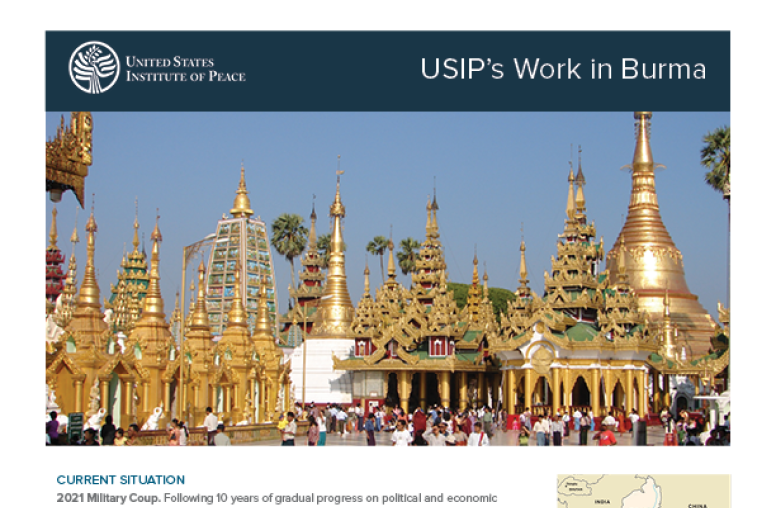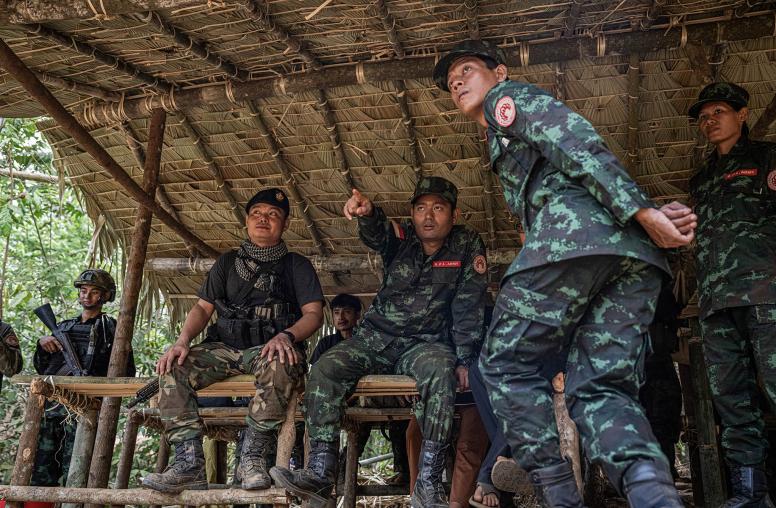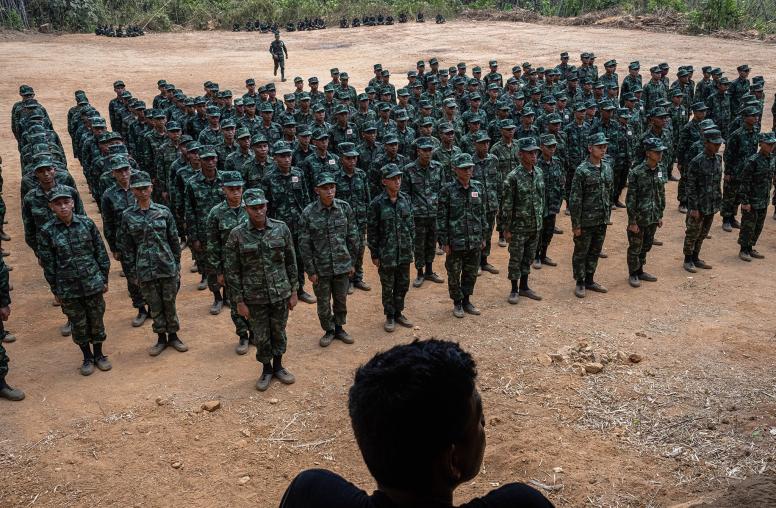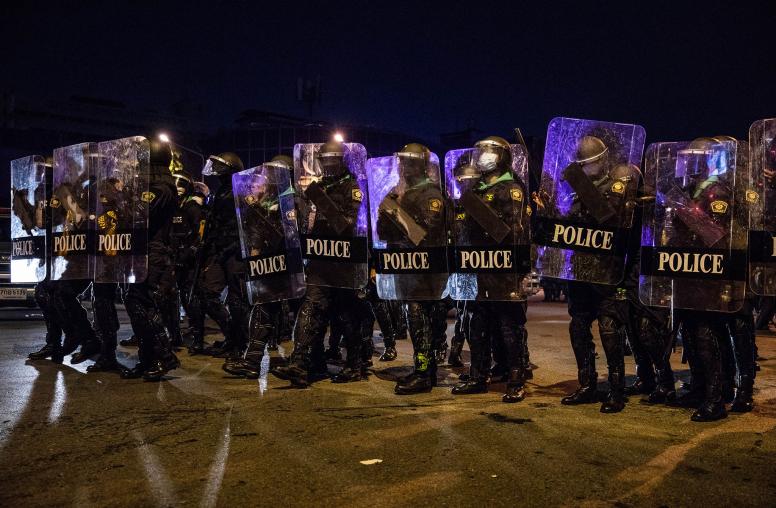Creating an Inclusive Burmese Peace Process
Burma's peace process reached a milestone with the October 2015 signing of the Nationwide Ceasefire Agreement. The Aung San Suu Kyi government, the most democratic in living memory, has prioritized the peace process; however, many women's and youth groups and other civil society organizations have been marginalized during the negotiations, their voices on important topics silenced in favor of elite input. As a result, a parallel track of activism aimed toward peacebuilding outside the formal structure has developed. The international community should support both tracks while continuing to urge the formal inclusion of marginal groups in the main process.
Summary
- Despite their important contributions to peace in Burma, women, youth groups, and civil society organizations have frequently been excluded from the existing elite-driven formal peace process.
- Nonetheless, numerous examples from conflict-affected areas underscore that the participation of groups typically excluded is key to influencing important aspects of the peace process and to effecting a durable peace.
- Multistakeholder political dialogues began in earnest in 2017. They may provide a space where more voices can be heard.
- The international community should support both parallel conversations but should also press for the direct inclusion of key stakeholders in all formal committees and processes.
Introduction
The current phase of Burma’s peace negotiations, which started in 2011 and were relaunched by Aung San Suu Kyi’s government in 2016, involves around twenty-one main ethnic armed organizations, eight of which have signed the Nationwide Ceasefire Agreement (NCA). The nonsignatory armed organizations are diverse in strength, interests, and alliances; some are in negotiations with the government and some are in deep conflict with the military, particularly in the northeast of the country. Simultaneously, a political dialogue mandated by the NCA has started, with the long-term (though contested) goal of changing Burma into a federal union in which the federal center shares power with regional centers, primarily reflecting the interests of ethnic minority populations. Progress toward ending violence and devising long-term solutions remains uncertain, feeding long-term trust deficits revolving around the inclusion of certain elite voices and the exclusion of others.
Women, youth groups, and civil society organizations (CSOs) have frequently been marginalized in the existing formal process despite their indispensable contributions to peace in Burma. These groups have vital experiences and insights to share that can strengthen the possibility of creating real and lasting peace. They represent constituencies whose buy-in to the process is essential. For these reasons, these groups should be given a larger platform going forward, both inside and outside the formal peace process.
Elite Versus Inclusive Processes
Burma’s peace process remains an elite one. The involved elites are not homogeneous but do tend to be largely male, older, military, and city-based. An end to fighting is the immediate goal, and that means that the armed actors who have fought each other dominate the initial conversation. Even if only the different military groups are counted, Burma’s peace process is already very complex. In a context with so many conflicting parties with diverse interests, it makes sense to have a carefully designed and well-managed process, but this should not mean an exclusive one.
The elite conversation in Burma has always run parallel to a broader political one about fundamental issues such as power and resource sharing and national identity, a conversation that needs to include all voices. A comparison of an elite negotiator with, for example, a female village head in a town in northern Shan who has been displaced multiple times and has successfully negotiated with both government representatives and nongovernmental armed actors on behalf of her community would quickly reveal who knows more about the realities of war. The contribution of women’s voices is also essential to addressing sexual violence in Burma’s war and other human rights violations. People who deal with conflict on a day-to-day basis are well qualified and even essential to delivering peace.
Inclusion and participation are important for both principled and pragmatic reasons. Pragmatically, peace processes are more sustainable if they are inclusive of a broad range of stakeholders. A study of 156 peace agreements showed that including women in a peace process increased the likelihood of peace lasting at least two years by 20 percent and increased the probability of an agreement lasting for at least fifteen years by 35 percent.1 Another study showed that CSO involvement in a peace process reduced the risk of a return to violence by up to 64 percent.2 As a matter of principle, particularly in a democratizing context, people have the right to be heard in a major process that affects their lives. As Margot Wallström, Sweden’s top diplomat, has said, “Inclusion is not just the right thing to do, it’s the smart thing to do.”3
How Groups Are Excluded from the Formal Process
Burma’s peace process, like many elsewhere, is led by armed men, and thus largely excludes CSOs, women, and young people. This disconnect is not one way: most of the ethnic armed groups are still illegal organizations, making it dangerous for civilians to openly associate with them, even for peacebuilding purposes. Involving only the elite, on the other hand, is also unsustainable because it allows those with narrow short-term interests to dominate negotiations. The root causes of the war are manifold and largely invisible to, at least poorly understood by, a small elite subgroup. Finding appropriate policy solutions therefore requires much greater inclusion of those most affected—nonelite, unarmed civilians. A review of their participation in the peace process shows significant room for improvement.
Women: At the August 2016 Union Peace Conference (also known as the 21st Century Panglong Conference), the first key political dialogue meeting under the National League for Democracy government, women made up around 13 percent of the attendees. Women’s groups were invited as observers only and so did not have opportunity to present their views publicly to decision makers and constituents.4 Women make up only 18 percent of the government’s top peace negotiating team; with respect to the cease-fire monitoring structures, no women at all are in the union-level Joint Monitoring Committee (JMC). The ethnic armed groups do even worse on this score: the signatories’ and nonsignatories’ negotiating teams (the Peace Process Steering Team and the Delegation for Political Negotiation, respectively) include zero women. Civil society forums in the peace process do a lot better on gender inclusion and are proactive in this regard.
Civil society organizations: On a positive note, CSOs participate in both the military aspects of the peace process, through cease-fire monitoring, and the political aspects of the process, the political dialogue process. CSO participation in both is limited, however. Civilian (including some CSO) members hold six out of twenty-six seats on the JMC at the union level, and two out of twelve seats at the state-level JMCs. Consequently, civilian members are a small counterweight to military members in the nascent cease-fire monitoring process. CSOs are allowed to carry out a political dialogue that runs parallel to and potentially feeds into the formal process, but this is not part of the main Panglong dialogue process, and CSOs are not allowed to contribute to a discussion of crucial political and security matters. These restrictions are contested, and the CSOs plan to continue their own forums, on topics of their choice, where they can. Unfortunately, the Union Peace Dialogue Joint Committee, the top-level committee in the political dialogue with the authority to change this structure, has no CSO members.
Youth: Young people have no formal voice in the peace process. However, a number of attempts have been made to recognize the voices of youth in the previous and current governments, and young people have organized forums of their own to raise issues of concern to them and their communities.
Gains to Be Realized Through Inclusive Participation
A peace process is only as good as its implementation, and the inclusion of marginalized groups can both energize and instill more faith in that process and produce greater societal investment in the outcome. In particular, an energized civil society sector could help engage the majority ethnoreligious (Bamar) population in the heartland, which remains largely disconnected from the ongoing conflict on the country’s periphery and inattentive to the peace process.
The participation of these marginalized groups aids the work of peacebuilding in six key ways:
- Improved accountability. Civilian cease-fire monitoring by women’s and other civilian organizations (such as the Karen Women Empowerment Group and Gender Development Initiative) has provided needed ground truthing for the implementation of both the bilateral cease-fire agreements and the NCA, and has spurred a push for greater civilian protection.
- Leading from behind. Many of the key thinkers who have helped move forward processes from behind the scenes by, for example, conducting research and drafting agreements have come from CSOs and youth and women’s groups.
- Promoting advocacy and awareness. Advocacy by the Alliance for Gender in the Peace Process and the Women’s League of Burma has resulted in some of the clauses of the NCA and other key documents more directly and substantively addressing sexual violence in conflict and the need to include women in political dialogues and in public life more broadly.
- Expanding the debate. Youth organizations have led peace marches to move the peace process into the mainstream. They went out on a limb with sensitive talks about ethnic and national identity at a large forum in Shan state last year.
- Influencing negotiations. Some CSOs—in particular ethnically based ones—have a huge influence on negotiations, such as those between the government and the Kachin Independence Organization, owing to their legitimacy in the community and their ability to mobilize people.
- Facilitating and providing safety nets. Perhaps most important, these groups provide safety nets when the formal process falters, as it frequently does. For example, initiatives led by CSOs at the state level have for some time been creating space for multistakeholder dialogues on peace and conflict issues and gathering input on political dialogue processes. This tactic builds infrastructure for the long-term success of a society by mobilizing grassroots organizations and strengthening networking among them. In a fractious society, more people-to-people contact and dialogue help promote understanding and a real and lasting national unity, which can never be imposed from above, regardless of the success of any peace deal.
Moving Forward in Inclusivity: Recommendations
Achieving inclusivity in Burma's peace process is not straightforward, and work toward this end has been beset with difficulties. Efforts by CSOs and women’s and youth groups have at times been diffuse and difficult to coordinate. In part this situation reflects a healthy diversity among these groups, which are far from homogeneous; in part it reflects the complex and evolving process under way. Some groups have preferred not to be part of formal structures, either out of mistrust or because they feel they can be more effective working outside the main process and engaging in parallel activities. That is to be expected: many marginalized groups in Burma are skeptical of the NCA. However, the voices of those who are wary of the peace process are just as crucial to crafting a long-term, sustainable peace as is the role of those organizations that are fully aligned with the mainstream peace agenda. The point is not to instrumentalize civilian organizations to support one peace agenda but to encourage and validate their contributions, even on a parallel path.
Despite these challenges, a number of recommendations to increase inclusion and raise stakeholder engagement in the peace process can be made. More authority could be given to the civilian members of the JMC and greater participation afforded civilian members in the verification of cease-fire violations, perhaps even the ability to adjudicate on certain violations. Ongoing advocacy by women and gender advocates inside the many political dialogue committees is key to broadening these agendas, holding peace process actors accountable for making good on their commitments to inclusivity, promoting women candidates for key positions, and supporting male champions of gender inclusion.
The political dialogues that were launched early in 2017 make it possible for many more voices to be heard. Peace process actors should maximize the opportunity afforded by those dialogues by advocating for greater participation in them and for broadening the space of inclusion. For instance, if CSOs were allowed to participate in the high-level political dialogue, from which they are currently excluded, they would be able to formally debate any topic they wished, rather than being limited to topics that are currently approved by the leadership of the Union Peace Conference.
The international community should support these efforts, not only by funding and supporting parallel processes of the political dialogues but also by pushing for direct inclusion of key stakeholders in all formal committees and processes. The complex and long-term nature of Burma’s peace process underscores the need for greater inclusion of multiple voices, perspectives, and experiences to achieve a sustainable peace. A diverse array of stakeholders, including CSOs, women’s groups, and youth groups, has already proven indispensable to this process.
Notes
- Laurel Stone, “Quantitative Analysis of Women’s Participation in Peace Processes,” in Reimagining Peacemaking: Women’s Roles in Peace Processes, ed. Marie O’Reilly, Andrea Ó Súilleabhán, and Thania Paffenholz (International Peace Institute, June 2015), Annex II, www.ipinst.org/wp-content/uploads/2015/06/IPI-E-pub-Reimagining-Peacemaking-rev.pdf. This is a study of 156 peace agreements, controlling for other variables.
- Desirée Nilsson, “Anchoring the Peace: Civil Society Actors in Peace Accords and Durable Peace,” International Interactions 38, no. 2 (2012): 243–66.
- See Government Offices of Sweden, "Women must be included for a sustainable peace," December 7, 2016, www.regeringen.se/debattartiklar/2016/12/kvinnor-maste-inkluderas-for-en-hallbar-fred/.
- Data from Alliance for Gender Inclusion in the Peace Process (AGIPP) research show that the number of women involved matters less than the nature of their involvement—not just as observers—and the timing of their involvement—not last minute, spending enough time to prepare—that makes the difference.
About this Brief
This brief by USIP’s Burma country director looks at Burma’s complex peace process and argues that, far from complicating the process, the participation of civil society, women’s, and youth groups is vital to the long-term success of negotiations.



